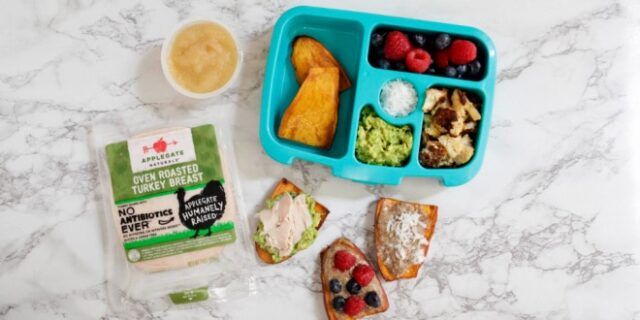Original post by Robin Strathdee; updated by Chelsea Long.
As parents, we do everything we can to keep our kids safe and healthy. We cover them in sunscreen, make them wear their seat belts, and teach them how to cross the street safely. When we make the change to a Whole30-inspired lifestyle, that desire naturally extends to the food that our kids eat. But the (frustrating, humbling, sometimes terrifying) truth of parenting is that we can’t control every situation.
Sooner or later, your kids will come face to face with OPF: Other People’s Food. As the holiday season approaches, you may find yourself faced with what feels like an endless sea of sugary treats. On top of that, you may have unsupportive family members questioning the food choices you make for your kids.
We’ll share three options for how to approach OPF in this post. You may decide on one you like and stick with it in all situations, or you may want to be flexible with your application. There’s no right or wrong answer; the choice is yours (well, mostly).
Plan #1 – Let it ride
Some parents choose to set the rules at home, but allow any/all off-plan foods in situations outside the home. This gives their kids the benefit of a primarily whole food lifestyle, but also gives them the opportunity to practice their food freedom in social situations. It also takes the pressure off of you to patrol them or other adults who might be feeding them.
This strategy can create some very teachable moments for your kids. You’ll have the opportunity to help your kids build the connection between what they eat and how they feel. Let’s say your teenager decides to eat pizza when he’s out with his friends and then spends the evening feeling sick. You can help him think about making a different choice next time. However, this benefit is only realized by kiddos who are old enough to make and understand their own choices. A two-year-old will almost always choose a cookie over a carrot, but they cannot understand the ramifications of that choice.
Read more about how to help your kids build awareness around their food choices.
Some parents feel that letting it ride with other people’s food can undermine the boundaries you set at home. There is no definitive answer to this debate, so you have to choose what’s more appropriate in your context.
One additional caveat—if your kids have allergies or intolerances, this is probably not the best plan for your family. It may help teach your kids to better control their own food lives, but the fallout as a result of that learning experience is often unpleasant enough to warrant complete avoidance.
Some considerations for this approach:
- If you’re trying to pinpoint a food-based cause for a physical or behavioral issue your child is having, this approach may prevent you from clearly identifying any triggers, particularly if your child is choosing them often outside of the house.
- By choosing to allow your kids food freedom like this, you’re essentially giving up your right to be unhappy with the outcome. You may want to give them autonomy, but it can be tough to see kids struggling with negative effects without nagging.
Plan #2 – Stay between the lines
You may not be comfortable letting your kids make all the rules when it comes to other people’s food. Consider setting some guidelines that apply in every situation. You may base these boundaries on known sensitivities, or just on foods that you know are less healthy choices. For example, you may decide that your child is always gluten-free when you’re dealing with food in your house and OPF. You find more compliance on your child’s part if you work together to create these ground rules. These are foods you know trigger unpleasant physical and/or behavioral reactions that are just not worth it. Outside of those boundaries, you may give your children more freedom in your choices.
When you choose this strategy it allows your kids (and/or the adults they’re with) to have a little more freedom with the menu, while giving you confidence that your kiddos are not going to suffer any substantial ill-effects. Having simple guidelines makes it easier for your kids to make good choices, and it makes it easier on other adults who may be making choices for your kids.
Of course, it can be hard to guarantee that your guidelines will be followed when you’re not there. That’s a part of teaching, and learning to trust our kids (and others) to respect boundaries in all areas of their lives.
Some considerations for this approach:
- This plan isn’t foolproof—there’s no guarantee that your guidelines will be followed 100% of the time. If your kids have serious intolerances or allergies you may want to consider a more controlled approach.
- This takes planning and communication. It may mean checking with your kids’ school at the beginning of the year to find out about food policies (will parents be bringing in surprise treats for birthdays?), finding out what the snack schedule is for soccer practice, and having conversations with other caretakers in your child’s life.
- You have to be willing to provide alternatives. Cupcake-toting parents at a school birthday party can’t be expected to understand and comply with your kiddos food rules, so there will be additional food preparation in your future for those special events that revolve around “treats.”
Read how Whole30 Coach Autumn navigates letting her five boys make food choices outside the home.
Plan #3 – My way or the highway
Other parents feel that the best plan for them is to control and/or provide any food their kiddo eats. This might be you if your child has serious food allergies or intolerances, you’re working to determine your kids’ intolerances (perhaps via a Whole30 or similar approach), or you believe that choosing foods that make your kids more healthy should always take precedence over social situations. The benefit of employing this strategy is (if executed properly) complete confidence in what your kids are eating plus reassurance that there won’t be any nasty fallout from other people’s food.
However, this is a pretty restrictive approach to feeding kids and puts a lot of stress on both you and your children. In addition, there’s a lot of truth to the idea that kids (read: humans in general) will gravitate toward things that are forbidden, especially without a real understanding of the reasoning behind the prohibition.
This plan may work well with younger kids who are not likely to be making any unsupervised (by you) food choices and can’t really question why things are non-negotiable. As kids get older, they may begin to question your rules—and that’s okay! That’s where one of the biggest responsibilities of parenthood—education—comes into play. This strategy only works if you and everyone who’s going to be feeding your kids are all in.
Some considerations for this approach:
- You’re going to be doing a lot of research and a lot of prep work. There’s no way around it. It’s not a bad thing, necessarily, just something you have to be prepared for. Every birthday party, sleepover at Grandma’s, or day out with friends will require either explicit instructions or packed food (sometimes both).
- Be prepared for a lot of questions. Again, not a bad thing. But if you’re not prepared for it, the barrage of questions can quickly become overwhelming.
The choice is yours
We’ve presented a few strategies for dealing with other people’s food here, but the reality is that you have to find what that works best for your family. That might be straightforward and unchanging, or it could be as flexible as a crazy straw. Just take a deep breath and think about what you’re currently doing. If that’s working for your family right now—great! If not, read through these strategies again to see how you might be able to make some changes.
In part two, we talk about who will be most likely to feed our kids and how to apply these strategies in real life. In the meantime, do you have any specific strategies for dealing with other people’s food? We’d love to hear them. Connect with us on Facebook or Instagram.
Originally posted October 2013 by Robin Strathdee.
Updated November 2018.















